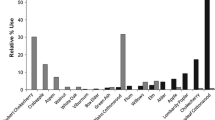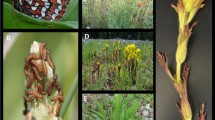Abstract
What happens when an exotic herbivore invades and encounters novel host plants and enemies? Here, we investigate the impacts of host plant quality and plant architecture on an exotic generalist herbivore, Epiphyas postvittana (Lepidoptera: Tortricidae) and its interactions with resident parasitoids in California. Using artificial diet and five plant species, we found significant effects of diet on the fitness of E. postvittana under laboratory conditions. In the field, based on a common garden experiment with host plants of nine species, we found that larval parasitism varied among plant species by a factor of 2.1 with a higher risk of parasitism on shorter than taller plants. Parasitism of egg masses varied by a factor of 4.7 among plant species with a higher risk of parasitism on taller than shorter plants. In the laboratory, the foraging time of a resident egg parasitoid on excised leaves varied among plant species, but did not correspond to observed egg parasitism rates on these same plants in the field. On leaves of Plantago lanceolata, the probability of egg parasitism decreased with trichome density. Overall, there was a significant effect of host plant on the intrinsic rate of increase of E. postvittana and on the extent of parasitism by resident parasitoids, but no correlation existed between these two effects. The recent decline of E. postvittana in California may be due to the low quality of some host plants and to the many resident enemies that readily attack it, perhaps due to its phylogenetic relatedness to resident tortricids.



Similar content being viewed by others
References
Agosta SJ (2006) On ecological fitting, plant-insect associations, herbivore host shifts, and host plant selection. Oikos 114:556–565. doi:10.1111/J.2006.0030-1299.15025.X
Agosta SJ, Klemens JA (2008) Ecological fitting by phenotypically flexible genotypes: implications for species associations, community assembly and evolution. Ecol Lett 11:1123–1134. doi:10.1111/j.1461-0248.2008.01237.x
Andow DA, Prokrym DR (1990) Plant structural complexity and host-finding by a parasitoid. Oecologia 82:162–165. doi:10.1007/BF00323530
Awmack CS, Leather SR (2002) Host plant quality and fecundity in herbivorous insects. Annu Rev Entomol 47:817–844. doi:10.1146/annurev.ento.47.091201.145300
Bezemer TM, Harvey JA, Cronin JT (2014) Response of native insect communities to invasive plants. Annu Rev Entomol 59:119–141. doi:10.1146/annurev-ento-011613-162104
Brockerhoff EG, Suckling DM, Ecroyd CE, Wagstaff SJ, Raabe MC, Dowell RV, Wearing CH (2011) Worldwide host plants of the highly polyphagous, invasive Epiphyas postvittana (Lepidoptera: Tortricidae). J Econ Entomol 104:1514–1524. doi:10.1603/Ec11160
Brown JW (2007) Discovery of light brown apple moth in North America. Torts 8:2
Bukovinszky T, Poelman EH, Kamp A, Hemerik L, Prekatsakis G, Dicke M (2012) Plants under multiple herbivory: consequences for parasitoid search behaviour and foraging efficiency. Anim Behav 83:501–509. doi:10.1016/j.anbehav.2011.11.027
Bürgi LP, Mills NJ (2014) Lack of enemy release for an invasive leafroller in California: temporal patterns and influence of host plant origin. Biol Invasions 16:1021–1034. doi:10.1007/s10530-013-0554-4
Bürgi LP, Roltsch WJ, Mills NJ (2015) Allee effects and population regulation: a test for biotic resistance against an invasive leafroller by resident parasitoids. Popul Ecol 57:215–225. doi:10.1007/s10144-014-0451-4
Carlsson NOL, Sarnelle O, Strayer DL (2009) Native predators and exotic prey –an acquired taste? Front Ecol Environ 7:525–532. doi:10.1890/080093
Caswell H (2001) Matrix Population Models: Construction, Analysis, and Interpretation. Sinauer Associates, Sunderland
Chabaane Y, Laplanche D, Turlings TCJ, Desurmont GA (2015) Impact of exotic insect herbivores on native tritrophic interactions: a case study of the African cotton leafworm, Spodoptera littoralis and insects associated with the field mustard Brassica rapa. J Ecol 103:109–117. doi:10.1111/1365-2745.12304
Clancy KM, Price PW (1987) Rapid herbivore growth enhances enemy attack: sublethal plant defenses remain a paradox. Ecology 68:733–737. doi:10.2307/1938479
Crawley MJ (2013) The R Book, 2nd edn. John Wiley & Sons Ltd., Chichester
Crowl TA, Crist TO, Parmenter RR, Belovsky G, Lugo AE (2008) The spread of invasive species and infectious disease as drivers of ecosystem change. Front Ecol Environ 6:238–246. doi:10.1890/070151
Cunningham N (2007) Light brown apple moth (LBAM) culture Epiphyas postvittana. Southern Australian Research and Development Institute, Australia
Danthanarayana W (1975) Bionomics, distribution and host range of Light Brown Apple Moth, Epiphyas postvittana (Walk) (Tortricidae). Aust J Zool 23:419–437. doi:10.1071/Zo9750419
Desurmont GA, Pearse IS (2014) Alien plants versus alien herbivores: does it matter who is non-native in a novel trophic interaction? Curr Opin Insect Sci 2:20–25. doi:10.1016/j.cois.2014.06.006
Desurmont GA, Harvey J, van Dam NM, Cristescu SM, Schiestl FP, Cozzolino S, Anderson P, Larsson MC, Kindlmann P, Danner H, Turlings TC (2014) Alien interference: disruption of infochemical networks by invasive insect herbivores. Plant Cell Environ 37:1854–1865. doi:10.1111/pce.12333
Desurmont GA, Laplanche D, Schiestl FP, Turlings TC (2015) Floral volatiles interfere with plant attraction of parasitoids: ontogeny-dependent infochemical dynamics in Brassica rapa. BMC Ecol 15:17. doi:10.1186/s12898-015-0047-7
Dicke M, Baldwin IT (2010) The evolutionary context for herbivore-induced plant volatiles: beyond the “cry-for-help”. Trends Plant Sci 15:167–175. doi:10.1016/j.tplants.2009.12.002
Elton C (1958) The ecology of invasions by animals and plants. Methuen & Co., Ltd., London
Feng Y, Wratten S, Sandhu H, Keller M (2015) Host plants affect the foraging success of two parasitoids that attack light brown apple moth Epiphyas postvittana (Walker) (Lepidoptera: Tortricidae). PLoS One. doi:10.1371/journal.pone.0124773
Geier PW, Briese DT (1981) The light-brown apple moth, Epiphyas postvittana (Walker): a native leafroller fostered by European settlement. In: Kitching R, Jones R (eds) The ecology of pests. CSIRO, Melbourne, pp 131–155
Godfray HCJ (1994) Parasitoids, Behavioral and Evolutionary Ecology. Princeton University Press, Princeton
Gols R (2014) Direct and indirect chemical defences against insects in a multitrophic framework. Plant Cell Environ 37:1741–1752. doi:10.1111/pce.12318
Gols R, Harvey JA (2009) Plant-mediated effects in the Brassicaceae on the performance and behaviour of parasitoids. Phytochem Rev 8:187–206. doi:10.1007/s11101-008-9104-6
Gripenberg S, Mayhew PJ, Parnell M, Roslin T (2010) A meta-analysis of preference-performance relationships in phytophagous insects. Ecol Lett 13:383–393. doi:10.1111/j.1461-0248.2009.01433.x
Gutierrez AP, Mills NJ, Ponti L (2010) Limits to the potential distribution of light brown apple moth in Arizona-California based on climate suitability and host plant availability. Biol Invasions 12:3319–3331. doi:10.1007/s10530-010-9725-8
Harvey JA, Fortuna TM (2012) Chemical and structural effects of invasive plants on herbivore-parasitoid/predator interactions in native communities. Entomol Exp Appl 144:14–26. doi:10.1111/j.1570-7458.2012.01252.x
Harvey JA, Bukovinszky T, van der Putten WH (2010) Interactions between invasive plants and insect herbivores: a plea for a multitrophic perspective. Biol Conserv 143:2251–2259. doi:10.1016/J.Biocon.03.004
Harvey JA, Ximenez de Embun MG, Bukovinszky T, Gols R (2012) The roles of ecological fitting, phylogeny and physiological equivalence in understanding realized and fundamental host ranges in endoparasitoid wasps. J Evol Biol 25:2139–2148. doi:10.1111/j.1420-9101.2012.02596.x
Harvey JA, Malcicka M, Ellers J (2015) Integrating more biological and ecological realism into studies of multitrophic interactions. Ecol Entomol 40:349–352. doi:10.1111/een.12204
Hilker M, Fatouros NE (2015) Plant responses to insect egg deposition. Annu Rev Entomol 60:493–515. doi:10.1146/annurev-ento-010814-020620
Hopper JV, Mills NJ (2016) Pathogenicity, prevalence and intensity of a microsporidian infection by Nosema fumiferanae postvittana in the light brown apple moth, Epiphyas postvittana, in California. J Invertebr Pathol 134:27–34. doi:10.1016/j.jip.2016.01.004
Janzen DH (1985) On ecological fitting. Oikos 45:308–310. doi:10.2307/3565565
Keane RM, Crawley MJ (2002) Exotic plant invasions and the enemy release hypothesis. Trends Ecol Evol 17:164–170. doi:10.1016/S0169-5347(02)02499-0
Kimbro DL, Cheng BS, Grosholz ED (2013) Biotic resistance in marine environments. Ecol Lett 16:821–833. doi:10.1111/ele.12106
Lenth RV (2016) Least-squares means: the R package lsmeans. J Stat Softw 69:1–33. doi:10.18637/jss.v069.i01
Levine JM, Adler PB, Yelenik SG (2004) A meta-analysis of biotic resistance to exotic plant invasions. Ecol Lett 7:975–989. doi:10.1111/J.1461-0248.2004.00657.X
Lozier JD, Mills NJ (2011) Predicting the potential invasive range of light brown apple moth (Epiphyas postvittana) using biologically informed and correlative species distribution models. Biol Invasions 13:2409–2421. doi:10.1007/s10530-011-0052-5
Lukianchuk JL, Smith SM (1997) Influence of plant structural complexity on the foraging success of Trichogramma minutum: a comparison of search on artificial and foliage models. Entomol Exp Appl 84:221–228. doi:10.1046/J.1570-7458.1997.00219.X
Maron JL, Vila M (2001) When do herbivores affect plant invasion? Evidence for the natural enemies and biotic resistance hypotheses. Oikos 95:361–373. doi:10.1034/J.1600-0706.2001.950301.X
Mitchell CE, Power AG (2003) Release of invasive plants from fungal and viral pathogens. Nature 421:625–627. doi:10.1038/nature01317
Mooney KA, Pratt RT, Singer MS (2012) The tri-trophic interactions hypothesis: interactive effects of host plant quality, diet breadth and natural enemies on herbivores. PLoS One 7:e34403. doi:10.1371/journal.pone.0034403
Nishida R (2002) Sequestration of defensive substances from plants by Lepidoptera. Annu Rev Entomol 47:57–92. doi:10.1146/annurev.ento.47.091201.145121
Obermaier E, Heisswolf A, Poethke HJ, Randlkofer B, Meiners T (2008) Plant architecture and vegetation structure: two ways for insect herbivores to escape parasitism. Eur J Entomol 105:233–240. doi:10.14411/eje.2008.033
Olson DM, Andow DA (2006) Walking pattern of Trichogramma nubilale Ertle and Davis (Hymenoptera; Trichogrammatidae) on various surfaces. Biol Control 39:329–335. doi:10.1016/j.biocontrol.2006.08.018
Pierik R, Ballare CL, Dicke M (2014) Ecology of plant volatiles: taking a plant community perspective. Plant Cell Environ 37:1845–1853. doi:10.1111/pce.12330
Price PW, Bouton CE, Gross P, McPheron BA, Thompson JN, Weis AE (1980) Interactions among three trophic levels: influence of plants on interactions between insect herbivores and natural enemies. Annu Rev Ecol Syst 11:41–65. doi:10.1146/annurev.es.11.110180.000353
R Core Team (2014) R: A language and environment for statistical computing. R Foundation for Statistical Computing, Vienna
Reinecke A, Hilker M (2014) Plant semiochemicals—perception and behavioural responses by insects. Annu Plant Rev 47:115–153. doi:10.1002/9781118472507.ch4
Romeis J, Babendreier D, Wackers FL, Shanower TG (2005) Habitat and plant specificity of Trichogramma egg parasitoids—underlying mechanisms and implications. Basic Appl Ecol 6:215–236. doi:10.1016/j.baae.2004.10.004
Singer MS, Stireman JO (2005) The tri-trophic niche concept and adaptive radiation of phytophagous insects. Ecol Lett 8:1247–1255. doi:10.1111/J.1461-0248.2005.00835.X
Singer MS, Mace KC, Bernays EA (2009) Self-medication as adaptive plasticity: increased ingestion of plant toxins by parasitized caterpillars. PLoS One 4:e4796. doi:10.1371/journal.pone.0004796
Singh P, Clare GK, Ashby MD (1985) Epiphyas postvittana. In: Singh P, Moore RF (eds) Handbook of insect rearing. Elsevier, Amsterdam, pp 271–282
Stubben CJ, Milligan BG (2007) Estimating and analyzing demographic models using the popbio package in R. J Statist Software 22:1–23. doi:10.18637/jss.v022.i11
Suckling DM, Stringer LD, Baird DB, Butler RC, Sullivan TES, Lance DR, Simmons GS (2014) Light brown apple moth (Epiphyas postvittana) (Lepidoptera: Tortricidae) colonization of California. Biol Invasions 16:1851–1863. doi:10.1007/S10530-013-0631-8
Thorpe KW (1985) Effects of height and habitat type on egg parasitism by Trichogramma minutum and Trichogramma pretiosum (Hymenoptera, Trichogrammatidae). Agric Ecosyst Environ 12:117–126. doi:10.1016/0167-8809(85)90072-6
Torchin ME, Lafferty KD, Dobson AP, McKenzie VJ, Kuris AM (2003) Introduced species and their missing parasites. Nature 421:628–630. doi:10.1038/nature01346
Uesugi A (2015) The slow-growth high-mortality hypothesis: direct experimental support in a leafmining fly. Ecol Entomol 40:221–228. doi:10.1111/een.12177
Verhoeven KJF, Biere A, Harvey JA, van der Putten WH (2009) Plant invaders and their novel natural enemies: who is naive? Ecol Lett 12:107–117. doi:10.1111/j.1461-0248.2008.01248.x
Wang X-G, Levy K, Mills NJ, Daane KM (2012) Light brown apple moth in California: a diversity of host plants and indigenous parasitoids. Environ Entomol 41:81–90. doi:10.1603/EN11160
Williams IS (1999) Slow-growth, high-mortality—a general hypothesis, or is it? Ecol Entomol 24:490–495. doi:10.1046/J.1365-2311.1999.00217.X
Zeileis A (2006) Object-oriented computation of sandwich estimators. J Statist Software 16:1–16. doi:10.1371/journal.pone.0093195
Acknowledgments
This study was funded by grants from USDA-APHIS, the California Department of Food and Agriculture, and a Van den Bosch Fellowship. We thank Steve Prinzivalli from Earth Networks-WeatherBug for access to climate data, Lisa Fernandez and Lauren Ponisio for statistical advice, Wayne Sousa and two anonymous reviewers for edits, the greenhouse staff for plant maintenance, and Aditi Dubi, Ahsan Mohammadi, Anna Mealy, Aryn Moore, Christina Lew, Cristina Cois, Ervin Herrera, Janice Oh, Jillian Keller, Gerid Ollison, Jonathon Trejo, Kevin Kai, Michael Fu, Priscilla Yung, Nina Nim, Nina Wani, Scott Kaplan and Somanette Rivas for their assistance with the experiments.
Author contribution statement
J.H. and N.M. initiated the study; J.H. acquired the data; led the analysis; the writing and presentation. J.H. and N.M. edited the manuscript.
Author information
Authors and Affiliations
Corresponding author
Additional information
Communicated by Carlos L. Ballare.
Electronic supplementary material
Below is the link to the electronic supplementary material.
Rights and permissions
About this article
Cite this article
Hopper, J.V., Mills, N.J. Novel multitrophic interactions among an exotic, generalist herbivore, its host plants and resident enemies in California. Oecologia 182, 1117–1128 (2016). https://doi.org/10.1007/s00442-016-3722-2
Received:
Accepted:
Published:
Issue Date:
DOI: https://doi.org/10.1007/s00442-016-3722-2




